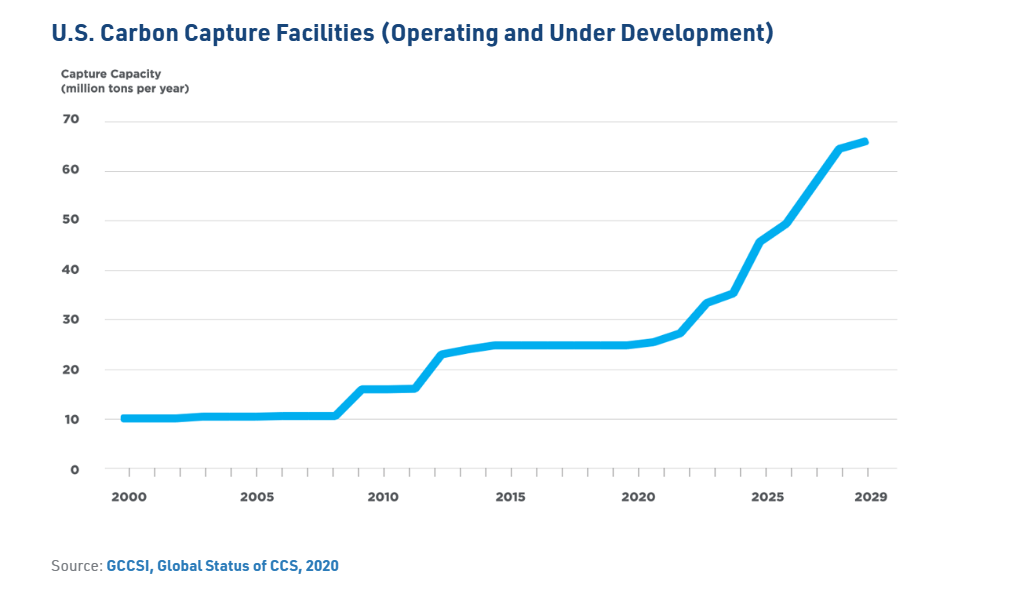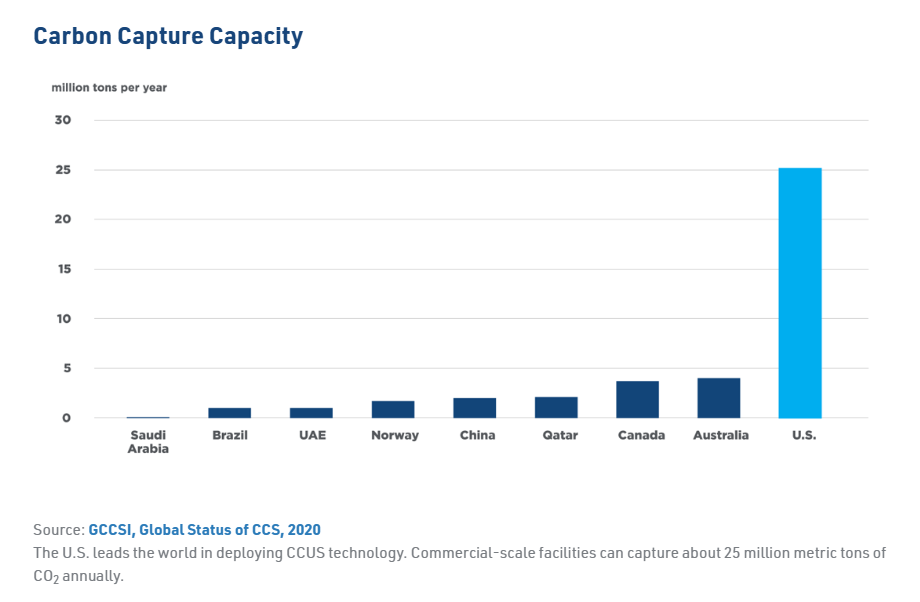The Energy Infrastructure Newsletter • Summer 2025
As an investment advisor, you have been subscribed to the Energy Infrastructure Newsletter so that you and your clients can stay abreast of this powerful emerging subsector. Formerly the MLP Newsletter, the Energy Infrastructure Newsletter is published in partnership with the Energy Infrastructure Council, a nonprofit trade association dedicated to advancing the interests of companies that develop and operate energy infrastructure. EIC addresses core public policy issues critical to investment in America’s energy infrastructure.
Carbon Capture, Utilization and Storage Development as Compared to the Shale Revolution:
Challenges Then and Now
Bryan J. Hanks, CPL, president and owner of BETA Land Services, LLC, spoke to Advisor Access about ways companies can be succeed despite challenging conditions.
Advisor Access: How does carbon capture, utilization and storage (CCUS) compare to the early challenges of the Shale Revolution?

Bryan Hanks: Many in our industry today are tasked with handling multiple developments of all forms of energy. We are all familiar with our traditional oil and gas assets—now add to that varying forms of renewable forms of energy, such as solar, wind and the varying developments associated with carbon capture. I will attempt to compare the challenges of the early days of the Shale Revolution with those we are seeing today around all things carbon.
I participated in those early days in various shale plays around the country, trying to explain unconventional or horizontal drilling to individuals and groups, and hosting or being a part of plenty of town halls in Pennsylvania, Ohio, Colorado, Illinois, Texas and Louisiana. We could sense the fear among people at that time was truly palpable and one could feel their sense of concern and urgency for themselves, their families and their communities. At the time, this new form of drilling was counterintuitive to anything we as a society had experienced. Couple that with going into communities and attempting to lease thousands of acres. In the past, there may have been trend plays covering large geologic/geographic areas, but for the most part associated developments involved units of drilling developments with much smaller footprints and fewer owners participating on a singular or even multiple developments.
We would most assuredly come across detractors and most definitely would have protestors or activists attend these town halls, but at least at that time there would remain a decorum or sense of respect during those events. While not always without emotions, voices would be raised, but at the end of the day, usually all parties agreed to continue the discussion and companies would continue to provide materials and educate the community.
The good news is the Shale Revolution has proven and continues to prove to be a huge success for those communities and across America with continued development in more and more communities with continued technological advancements.
AA: What changed?
BH: The major changes we have seen in social and traditional media has meant the evolution of extreme partisanship in our nation’s capital, which has trickled down to our state capitals and to local governments. We also now see huge sums of money attempting to influence all sides of these discussions on carbon. One of the most challenging scenarios is that companies attempting to develop carbon projects are finding themselves in battles, both from the far left and from the far right. There is far less willingness to gather and discuss; battlelines are being drawn and promoted by—usually—a few loud and disruptive voices. Some of the battle cries include personal rights vs. eminent domain, destruction of local water sources from migration through wells in and above these injection formations, the idea that people will die when pipelines explode, that vehicles will shut down and a “sea-like fog” will migrate across all our community—these are just a few examples. The fear mentioned above related to the Shale Revolution has been built into a weaponization tool for these detractors to a level never seen before.

Chart courtesy of the American Petroleum Institute
AA: What can industry do?
BH: The opportunities for all going forward are only beginning to be appreciated and understood. The progress in the past four years is tangible, and companies have invested billions on many yet-to-be-developed opportunities. Up until a year or two ago, the dominant focus for carbon projects was industrial development, but now energy-intensive artificial intelligence (AI) and data centers are being planned on a phenomenal basis across the country.
In my experience, companies that are truly proactive have been the most effective. From day one, they meet with local officials and individuals and they present a community development plan involving all stakeholders in the area. Many have started STEM (Science, Technology, Engineering and Mathematics) classes at both the middle and high school level in those communities. Town Hall meetings provide education materials and discussions. Importantly, they involve local and state politicians from the earliest stages so these individuals can be ambassadors for the company from day one. They tend to be trusted voices in those areas that can quash outside voices, which are paid to come in and disrupt. Having safety program structures or visions ready for these early meetings and seeking input from local governmental bodies makes them feel part of the process.
Will there still be detractors and activists—yes—but making bonafide good faith attempts toward these communities will go a long way toward cooperation and support from locals, which is invaluable.

Chart courtesy of the American Petroleum Institute
Industry also has to police itself—eminent domain has been in the headlines nationally and in individual states. Many of these projects will require carbon capture pipelines to carry the product to and from an originating source to an injection point. South Dakota has passed a law banning the use of eminent domain for carbon capture pipelines. Iowa and Louisiana are considering various forms of legislation to do the same or modify it to some degree. Studying the source of growing angst with eminent domain, in many instances companies have adopted a policy where, in states that allow eminent domain, they instruct their landmen (or their associated sub-contractors) to make an offer to a landowner. If the landowner does not accept, they immediately let the landowner know the company will be moving forward with eminent domain proceedings to secure that portion of the landowner’s property needed for the carbon capture pipeline. Consequently, landowners and communities and now states are taking a stand on this perception/reality of a company forcing a landowner to accept the offer or be figuratively run over.
Having been a landman for over 44 years, I can tell you this is not a prudent policy—the beauty of our industry is that we provide a tremendous opportunity for landowners that they could never imagine or benefit on their own—both the landowner and the company can succeed and establish a successful revenue stream for both through cooperation with a successful project.
There is an attempt to provide legislation to address this type of strategy without having the company jump directly to eminent domain by way of simply making sure multiple contacts are made among parties.
In closing, a quote from Tim Hunter, chief technical advisor with production enhancement for Halliburton, in an article in E&P by Hart Energy, “Celebrating 75 Years of The Frac,” sums up for CCUS what he stated for shale development: “Good design work looks obvious in the end. It’s not easy to get there. And a lot of people might say, ‘Well, I could have done that.’ But it’s not easy to see out the windshield; it’s easy to see in the rearview mirror. I think the shale development is exactly that.”
AA: Thank you for your insights, Bryan.
Bryan J. Hanks, CPL, is president and owner of BETA Land Services, LLC. He is a Certified Professional Landman who has over 41 years of experience in all phases of landwork including title research, lease acquisition, due diligence, seismic acquisition, pipeline right-of-way project management—including route and site selection, landowner negotiations, contract preparation, ROW easement amendments and modifications, solar, wind, transmission line acquisition, carbon sequestration and battery storage. These tasks have taken place in over 39 states, as well as Alberta, Canada. He and his companies have been involved in assisting several companies as they became publicly traded, with at least four that have a current market value in excess of several billion dollars. His current company, BETA Land Services, has hundreds of landmen and is currently or has been involved in over 100 company acquisitions totaling over $39.26 billion since 2010 with properties located in over 39 states. Since 2010, this work has encompassed more than 3,593,656 acres, as well as oil and gas lease purchases of more than 746,926 acres, and has involved more than 26,027 wells.
Mr. Hanks is involved in several state and national professional organizations such as the American Association of Professional Landmen (AAPL), International Right of Way Association (IRWA), Southern Gas Association (SGA), Lafayette Association of Professional Landmen (LAPL), Houston Association of Professional Landmen (HAPL), West Houston Association of Professional Landmen (WHAPL), Denver Association of Petroleum Landmen (DAPL), Professional Landmen’s Association of New Orleans (PLANO), and was President and Landman of the Year of the Lafayette Association. Mr. Hanks served as Chairman of the Louisiana Oil & Gas Association (LOGA) from 2012 until 2018, as well as continuing to serve on LOGA’s Board of Directors since 1997. Additionally, Mr. Hanks has been Chairman of LOGA’s Gulf Coast Prospect Exposition (GCPE) three of its 14 years of existence. He is Vice Chairman of the University of Louisiana – Lafayette (ULL) Board of Trustees, as well as on that organization’s Executive Committee. Additionally, Mr. Hanks is a past Chairman of the Board and Executive Committee of the Ragin Cajun Athletic Foundation (RCAF). Mr. Hanks is on the Board of the Louisiana Association of Business and Industry (LABI), serving as past Chairman and current member of LABI’s Energy Council, since 2018. He has also served on the Executive Committee of the Lafayette Chamber of Commerce, as well as two terms on the Board of Directors at the Lafayette Petroleum Club. Mr. Hanks currently serves as Chairman and is on the Executive Committee of the Board of Our Lady of Lourdes Hospital.
DISCLOSURES
The material, information and facts discussed in this report are from sources believed to be reliable, but are in no way guaranteed to be complete or accurate. This report should not be used as a complete analysis of the company, industry or security discussed in the report. This is not an offer or solicitation of the securities discussed. Advisor-Access LLC and/or its employees, contractors and owners, may purchase or sell the securities mentioned in this report from time to time. Any opinions or estimates in this report are subject to change without notice. This report contains forward-looking statements. This information may involve risks and uncertainties that could cause actual results to differ materially from the forward-looking statements. The securities discussed may involve a high degree of risk and may not be suitable for all investors. The author had final approval of the content and is wholly responsible for the validity of the statements and opinions.
The EIC Newsletter for Advisors is solely distributed by Advisor Access. The Advisor Access full disclaimer is to be read and fully understood before using our site. By viewing our website, you are agreeing to our full disclaimer which can be read at: www.advisor-access.com/disclaimer.
The EIC is a registered trademark of the Energy Infrastructure Council and information provided by the EIC in this newsletter or on the website may not be used without the written consent of the EIC. Contact the EIC directly for said permission: lori@eic.energy.
Newsletter Sponsors have paid Advisor Access a fee to include their corporate logos in this newsletter and as such their logos are to be considered advertising. Sponsor logos are the trademarks and property of the individual companies.
ABOUT ADVISOR ACCESS
Advisor-Access LLC was designed to bring compelling investment ideas to investors in the form of in-depth interviews with company management and the latest fact sheets and corporate presentations, in a concise format: the critical pieces of information an investor needs to make an informed investment decision.




